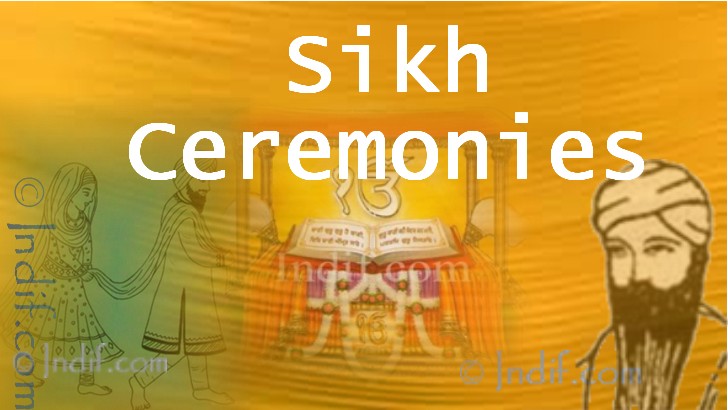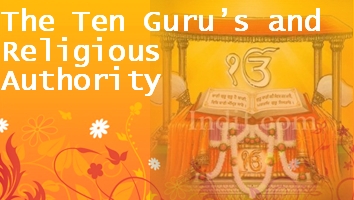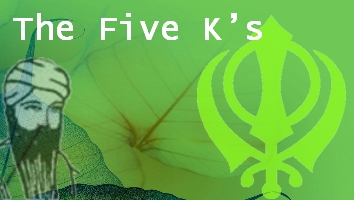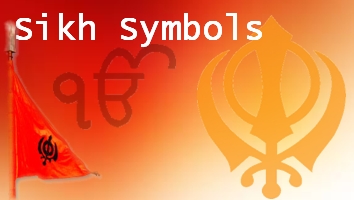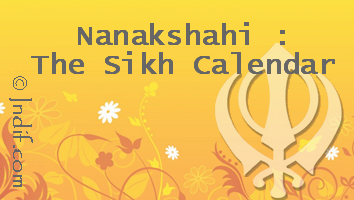ੴ
AKHAND PAATH CEREMONY (Reading of Holy Book):
Akhand
Path, ਅਖੰਡ ਪਾਠ,
means the
continuous
(non-stop)
recitation of
the
Guru Granth
Sahib (the
sikh holy book)
from beginning
to end.
Akhand
means
uninterrupted,
without any
break and
Path
means
reading.
This reading
must go on day
and night,
without a
moment's
intermission. It
is normally
completed within
48 hours.This
Akhand path is
considered a
very holy
practise and is
said to bring
peace and
solace.
he
non-stop reading
of the Guru
Granth Sahib is
undertaken for
various
reasons.It can
be on occasions
of elation or
joy within the
family, in sad
or hard times,
or simply to
increase one?s
feeling of
connection to
the Guru. The
relay of
reciters who
take turns at
reading the
holybook must
ensure that no
break occurs in
the reading. As
they change
places at given
intervals, one
picks the line
from his
predecessor's
lips and
continues.
During the
reading it is
tradition for
langar (or
communal food)
to be available
at all times,
thus requiring
the continual
service and
dedication of
those in whose
honour the
Akhand Path is
being held for.
Akhand Path is
supposed to be
read loud, clear
and also it
should be
correct. even
though that
takes a little
longer to
complete. After
the completion
of the reading
the bhog
ceremony takes
place. A Hukam
is taken by
randomly turning
to any page and
reading the hymn
on that page
followed by
Ardas. Karah
Parshad (sacred
pudding) is also
distributed to
all present.
ANTIM SANSKAR CEREMONY (Funeral Ceremony):
In Sikhism "Antim Sanskar," means the funeral ceremony or celebration of the completion of life. In Sikhism death is considered a natural process and reunion of the soul with its maker. Cremation is the usual method for disposal of remains regardless of the age of the deceased in Sikhism. But if it is not possible any other method such as burial or submergence at sea are acceptable. The body is usually bathed and clothed by family members. The hair is covered with a turban or traditional scarf as usually worn by the individual who has passed away. The karkars, or five articles of faith worn by a Sikh in life, remain with the body in death. Before cremation hymns are recited which induce feeling of detachment are recited by the congregation. As the body is being cremated, Kirtan Sohila the nighttime prayer is recited and Ardas is offered. The ashes of the deceased be buried in the earth scattered over or immersed in flowing water such as a river or sea. A non continuos reading of the entire Sri Guru Granth Sahib is undertaken and timed to conclude on the tenth day. This may be undertaken at home or in the Gurdwara. The conclusion of this ceremony known as bhog ceremony marks the end of the mourning period. During bhoj ceremony, all the relatives and friends of the family gather together for the completion of the reading of Guru Granth Sahib. Ragi's (Musicians) sing appropriate Shabads hymns, Saloks of the ninth Guru Tegh Bahadur are read, and Ramkali Saad, the Call of God, is recited. After the final prayer, a random reading or Hukam is taken, and Karah Parshad (sacred pudding) is distributed to the congregation. Finally, food from the Guru's kitchen, Langar (or communal food), is served. The conclusion of this ceremony marks the end of the mourning period.

